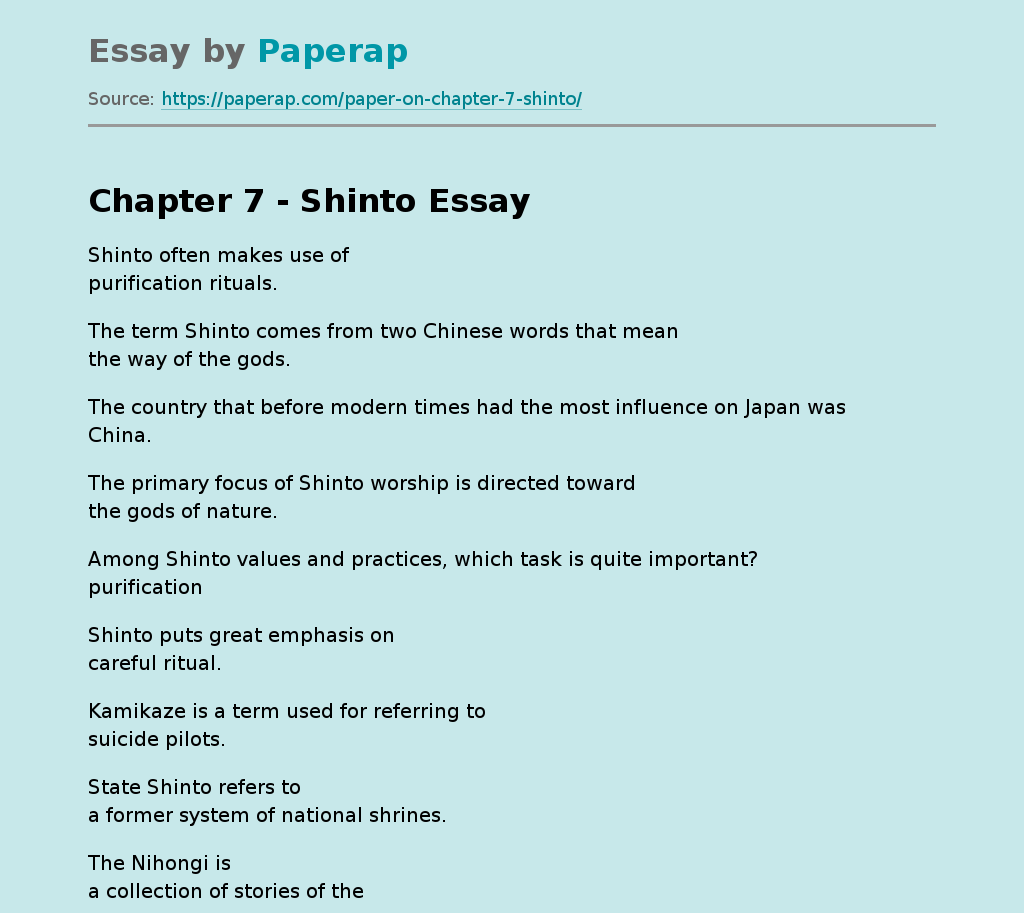Chapter 7 - Shinto
Essay,
Pages 3 (686 words)
Views
253
Shinto often makes use of
purification rituals.
The term Shinto comes from two Chinese words that mean
the way of the gods.
The country that before modern times had the most influence on Japan was
China.
The primary focus of Shinto worship is directed toward
the gods of nature.
Among Shinto values and practices, which task is quite important?
purification
Shinto puts great emphasis on
careful ritual.
Kamikaze is a term used for referring to
suicide pilots.
State Shinto refers to
a former system of national shrines.
The Nihongi is
a collection of stories of the gods and early history.
The ideal of the warrior, promoted by Shinto during World War II, is called
bushido.
The emperor renounced his title to divinity when
World War II ended.
The sun goddess of Shinto is
Amaterasu.
Tenrikyo, which grew out of Shinto, has its headquarters near
Nara.
The founder of Tenrikyo was
Nakayama Miki.
Omoto is a new religion that emphasizes the value of
art.
Omoto, in order to encourage international understanding, gives a special place to the study and use of
Esperanto.
Shinto and Buddhism
began to blend soon after the introduction of Buddhism.
The Japanese people
seem to be a blend of several peoples.
It has been a traditional teaching that the imperial family is descended from what kami?
Amaterasu
It is possible that the creation myth that tells of numerous kami
unites the beliefs of several clans or tribes.
Shinto and Confucianism particularly had what feature in common?
veneration of ancestors
The emperor of Japan came to be considered a father figure for the whole country.
This
seems to show the influence of Confucianism.
The primeval female kami who was burned by the fire god is
Izanami.
Shinto
has helped the Japanese maintain a sense of their unique identity.
Izanami and Izanagi created Japan when they stirred the ocean with
a jeweled spear.
Izanagi searched for Izanami
in the underworld.
The basis for the Japanese writing system came from
China
The goddess Amaterasu was lured from a cave, where she was hiding, by
dancing nearby.
The Church of World Messianity (Sekaikyu Seikyo) is an offshoot o
Omoto
The Shinto deity of rice and good harvest is
Inari
The islands of Japan, according to the creation story, are a sort of this-worldly heaven because
humans share the islands with divine beings who live there.
Part of the accommodation between Shinto and Buddhism included
a division of focus with Buddhism associated with philosophy, death and afterlife while Shinto was called on for agriculture and fertility.
During the Meiji Restoration, Shinto became tied to growing nationalism through
emphasis on the divine origins of the emperor.
The color most often associated with Shinto is
white
Among the numerous kami are the powers of nature; spirits associated with particular places in nature such as trees, waterfalls, and mountains; the ancestors; and
animal spirits.
A special New Year’s ritual in Shinto is
rice pounding.
The torii is
often used as a gateway to a sacred location.
The name for a god in Shinto is
kami
The Shinto shrine that is dedicated to Amaterasu and is the shrine of the imperial family is located at
Ise
A major Shinto shrine in Tokyo is named after what emperor?
Meiji
An important element of ritual at a Shinto shrine is
hand clapping.
Japji means “Conqueror”; the Jain term for a perfected person who will not be reborn.
false
Khalsa is the community of initiated Sikhs.
true
A Digambara is a Sikh temple.
false
Puja means “disciple”; a follower of the Sikh religion.
false
The Adi Granth is the “original collection”; the primary scripture of the Sikhs.
True
Adi Granth means “Holy Death”; death by self-starvation, valued in Jainism as a noble end of a long life of virtue and detachment.
False
Tirthankara means “crossing maker”; in Jainism, one of the twenty-four ideal human beings of the past, Mahavira being the most recent.
true
Ahimsa is a poem by Guru Nanak that begins the Adi Granth; the poem is recited daily by pious Sikhs.
False
Punjab, in Jainism, means ritual in honor of tirthankara.
False
Chapter 7 - Shinto. (2017, Dec 28). Retrieved from https://paperap.com/paper-on-chapter-7-shinto/

